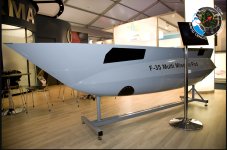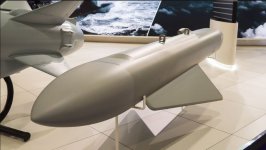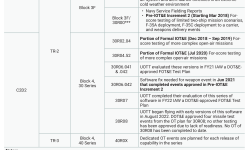This:
View attachment 44618
Basically, a low/mid-band jamming solution that has it's own power supply instead of the constrained internal solution. That means a pod.
What does that matter? That's the limitation of the jet in question, same as Gripen E.
MKI is in the same boat.
Podded jammer for F-35 is just an offer by Terma (Denmark). It's mostly aimed at those Air Forces that plan to operate F35-only fleets. It would be pretty stupid (and pointless) to put a standoff jammer on a VLO jet, unless of course you don't have any other jet in hand.
USAF/USN maintain that F-35 won't be carrying any podded jammer for this role, at least for as long as the Growler is still around.
F-35 will carry the NGJ in the MMP, after Block 4 is developed.
No, EK is not for standoff jamming (like ESJ) but only escort jamming. It also means that the low-band Arexis is unlikely to be involved. Only the mid/high-band ones.
Also, the EK itself is gonna be the launch platform for AARGM. So no, there ain't gonna be any penetrating manned aircraft going much further in than the EK, or atleast anywhere outside the protective bubble of EK, until after the EK has destroyed the threat radars (unless you have F-35 in hand, which all Typhoon operators save for MidEastern ones do).
Lol. The Arexis jammer pod I put up is what's going on the Typhoon EK. It will carry 2 such pods for operation from VHF to S band.
AARGM is a standoff missile.
You are basically describing what I have already said.
You need Typhoon EK (VHF-S)+ Praetorian Evo (C-Ku).
Similarly Rafale needs ESJ (VHF-S) + SPECTRA (C-Ku).
The only difference is the ESJ works from longer range than the Typhoon EK. Both are meant for standoff and modified escort jamming.
You're just weakening your own argument.
If SPECTRA couldn't reliably save the Rafale even at those ranges, that doesn't inspire confidence against something like J-35 that's capable of closing the distance significantly.
If a Rafale was lost, we don't know the conditions of the loss. They are guessing a crash or a friendly fire.
From what's been suggested, no jets were lost to enemy fire.
The ESJ can play no real part here anyway. J-10C is an X band radar and PL-15 uses a Ku band seeker. Neither can be defeated by ESJ or Typhoon EK. This is where SPECTRA and Praetorian come in.
I'm saying "the point of a bigger bottle is that it can hold more water" and you're saying "the point is that it can quench more thirst".
You're just arguing for sake of arguing.
I'm saying "the point of a bigger bottle is that it can hold more water" and you're saying God knows what, neither the bottle nor the water.
There are limits. You can only pump so much power through a sensor on a certain platform. If you want to effectively jam a certain target, you can only be so far away from it. You can't just start magically jamming the same target from twice or thrice as far away as before just because the enemy managed to double the range of his AAMs against lumbering targets.
Huh? Yes, you can. You are always talking the opposite of established and well-known facts.
You want more power, you increase the array size, it's that simple. That's why pods provide bigger arrays.
Living, breathing example right here.
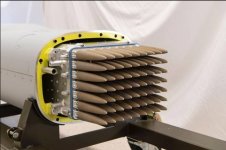
This is what the Typhoon EK will use. You can't put this on a fighter jet without compromising aerodynamics, hence you use pods. And the larger the pod, the greater the jamming distance.
The bigger the acraft, the more surface area you get, the bigger the array, the greater the power, the longer the range. It's that ridiculously elementary.
The ESJ will be able to carry even more than this if necessary.
Look at the sheer size of the NGJ.
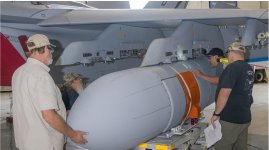
Cuz the latter is relatively straightforward (add more fuel/second pulse), but the jammer's job is much more complicated. Hint: the radar equation.
Why don't you try explaining via the radar equation then?
...Erm, how exactly is any of this contradicting what I said regarding Rafale needing all the same kit that Typhoon EK will need?
Everything you said contradicts with basic logic.
You used the ESJ as an excuse to dismiss SPECTRA without understanding the complementary nature of the system or without even realizing that even stealth requires this complementary system.
As a 5th gen jet, the F-35's main weakness is it's visible to VHF and UHF radars from max range and to a certain extent to L band radars too. So the F-35 needs standoff jammer support in this frequency range or it's not survivable.
Anyway, this is what you said:
But I was lead to believe that Active Cancellation/ACT can spoof anything & penetrate by itself, evading everything by flying low
What the frick has ESJ got to do with Rafale's ACT or flying low? There's literally no relation between the two. Whether the Rafale flies high or low or uses ACT or not, the ESJ's job is to defeat VHF-S band radars from long distance, that's all. In an ideal world, the ESJ will defeat all long wave radars and communication systems and Rafale can fly in with a flying barn in tow if necessary and still survive. The ESJ's effectiveness has nothing to do with Rafale or SPECTRA or F-35 or NGAD or B-21 or anything. In an ideal world, the ESJ will even protect long range weapons from being detected. You completely lack such a basic understanding of this subject.
If long wave radars are defeated from standoff ranges, then SPECTRA has an easier job for survival. And if Typhoon EK does the same from long range, then Praetorian Evo will have an easier job. That's literally all there is to it.



